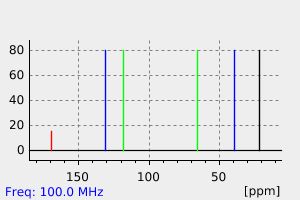2-溴丙酸烯丙酯 | 87129-38-2
中文名称
2-溴丙酸烯丙酯
中文别名
——
英文名称
allyl 2-bromopropionate
英文别名
allyl 2-bromopropanoate;prop-2-enyl 2-bromopropanoate
CAS
87129-38-2
化学式
C6H9BrO2
mdl
——
分子量
193.04
InChiKey
FHZWOBCLWMGXII-UHFFFAOYSA-N
BEILSTEIN
——
EINECS
——
-
物化性质
-
计算性质
-
ADMET
-
安全信息
-
SDS
-
制备方法与用途
-
上下游信息
-
文献信息
-
表征谱图
-
同类化合物
-
相关功能分类
-
相关结构分类
物化性质
-
沸点:50 °C(Press: 7 Torr)
-
密度:1.381±0.06 g/cm3(Predicted)
计算性质
-
辛醇/水分配系数(LogP):2
-
重原子数:9
-
可旋转键数:4
-
环数:0.0
-
sp3杂化的碳原子比例:0.5
-
拓扑面积:26.3
-
氢给体数:0
-
氢受体数:2
安全信息
-
安全说明:S16,S26,S36/37/39
-
危险类别码:R10,R36/37/38
-
海关编码:2915900090
-
危险品运输编号:UN 1993
SDS
上下游信息
-
下游产品
中文名称 英文名称 CAS号 化学式 分子量 丙酸烯丙酯 prop-2-enyl propanoate 2408-20-0 C6H10O2 114.144
反应信息
-
作为反应物:描述:2-溴丙酸烯丙酯 在 Pt(0) 1,3-divinyl-1,1,3,3-teramethyldisiloxane complex 吡啶 作用下, 以 乙醚 为溶剂, 反应 3.0h, 生成 [3-(2-bromopropionyl)propyl]dimethyl(methoxy)silane参考文献:名称:通过表面可逆加成-断裂链转移聚合反应将定义良好的聚合物刷接枝到二氧化硅纳米颗粒上摘要:可逆加成-断裂链转移聚合(RAFT)用于制备接枝到二氧化硅纳米粒子上的聚合物刷。制备了同时含有活性RAFT部分和硅烷偶联剂的新型RAFT-硅烷试剂。通过用RAFT-硅烷试剂将胶体二氧化硅官能化,将RAFT试剂锚定在二氧化硅纳米颗粒上。然后从颗粒表面进行RAFT聚合反应,以接枝均聚物,然后将嵌段共聚物刷涂到颗粒上。苯乙烯(St)和丙烯酸正丁酯(nBuA)表面RAFT聚合进行了研究,并与游离RAFT剂介导的模型聚合进行了比较。接枝聚合物的分子量随转化率线性增加,在所研究的转化率范围内观察到一级动力学,表明表面接枝聚合以受控方式进行。还制备了附着在二氧化硅纳米颗粒上的定义明确的PSt嵌段-PBuA共聚物。DOI:10.1021/ma050216r
-
作为产物:参考文献:名称:化学和对映选择性钯催化的α-硝基酯脱羧不对称烯丙基烷基化反应的研究摘要:我们描述了α-硝基烯丙基酯的Pd催化脱羧不对称烯丙基烷基化反应的发展,以提供无环四取代硝基烷烃。反应参数的优化揭示了独特的配体和溶剂组合,这些组合对于实现具有电子挑战性的亚硝酸苄酯和空间受限的2-烯丙基酯的化学和对映选择性C烷基化至关重要。通过交叉克莱森/α芳基化序列以组合方式有效地访问底物。该方法提供的官能团正交性可补充用于α-叔胺合成的亲核亚胺烯丙基化策略。DOI:10.1002/anie.201904034
文献信息
-
General Route for Preparing β-Nitrocarbonyl Compounds Using Copper Thermal Redox Catalysis作者:Amber A. S. Gietter、Peter G. Gildner、Andrew P. Cinderella、Donald A. WatsonDOI:10.1021/ol5014153日期:2014.6.6Using a simple copper catalyst, the alkylation of nitroalkanes with α-bromocarbonyls is now possible. This method provides a general, functional group tolerant route to β-nitrocarbonyl compounds, including nitro amides, esters, ketones, and aldehydes. The highly sterically dense, functional group rich products from these reactions can be readily elaborated into a range of complex nitrogen-containing
-
Studies on the Synthesis of Kijanolide: Synthesis of an Advanced Seco-acid Intermediate作者:William R. Roush、Hou Chen、Melissa L. ReillyDOI:10.3987/com-02-s(m)17日期:——A synthesis of an advanced seco acid intermediate (7) in a projected total synthesis of kijanolide is described. Key steps in the synthesis of 7 include the highly diastereoselective allylation reaction of 15, the Suzuki cross coupling of dienyl iodide (11) and vinylboronic acid (12), and the IMDA reaction of 9. Elaboration of the spirotetronic acid unit of 7 was accomplished by a Dieckmann cyclization
-
Total synthesis of two potent anti-inflammatory macrolactones of the oxacyclododecindione type作者:Johannes Tauber、Markus Rohr、Thorsten Walter、Gerhard Erkel、Till OpatzDOI:10.1039/c5ob01044f日期:——An esterification/Friedel–Crafts-cyclization approach permitted the first successful synthetic entry into the oxacyclododecindione subclass of the dihydroxyphenylacetic acid lactone-type natural products. This route allowed the preparation of two highly active anti-inflammatory fungal secondary metabolites 14-deoxyoxacyclododecindione and 14-deoxy-4-dechlorooxacyclododecindione as well as their 14-desmethyl
-
Reformatsky-type addition of esters of α-halogeno carboxylic acids to aldehydes and ketones in the presence of Fe(CO)5作者:A. B. Terent'ev、T. T. Vasil'eva、N. A. Kuz'mina、E. I. Mysov、N. S. Ikonnikov、N. Yu. Kuznetsov、Yu. N. BelokonDOI:10.1007/bf02496013日期:1999.6Reformatsky-type addition of esters of α-halogeno carboxylic acids to aldehydes and ketones in the presence of Fe(CO)5 and an activating agent (CBrCl3 or I2) afforded the corresponding esters of β-hydroxy acids in good yields. Possible reaction mechanisms are discussed.
-
Isolation, Structure Elucidation, Biosynthesis, and Synthesis of Antalid, a Secondary Metabolite from <i>Polyangium species</i>作者:Thomas Tautz、Judith Hoffmann、Thomas Hoffmann、Heinrich Steinmetz、Peter Washausen、Brigitte Kunze、Volker Huch、Andreas Kitsche、Hans Reichenbach、Gerhard Höfle、Rolf Müller、Markus KalesseDOI:10.1021/acs.orglett.6b00810日期:2016.6.3The isolation, structure elucidation, and synthesis of antalid (1), a novel secondary metabolite from Polyangium sp., is described herein. The structure elucidation of 1 was performed with the aid of mass spectrometry, high field NMR experiments, and crystal structure analysis. The absolute configuration of antalid was confirmed through the Mosher ester method and ultimately by total synthesis. In
表征谱图
-
氢谱1HNMR
-
质谱MS
-
碳谱13CNMR
-
红外IR
-
拉曼Raman
-
峰位数据
-
峰位匹配
-
表征信息
同类化合物
(甲基3-(二甲基氨基)-2-苯基-2H-azirene-2-羧酸乙酯)
(±)-盐酸氯吡格雷
(±)-丙酰肉碱氯化物
(d(CH2)51,Tyr(Me)2,Arg8)-血管加压素
(S)-(+)-α-氨基-4-羧基-2-甲基苯乙酸
(S)-阿拉考特盐酸盐
(S)-赖诺普利-d5钠
(S)-2-氨基-5-氧代己酸,氢溴酸盐
(S)-2-[[[(1R,2R)-2-[[[3,5-双(叔丁基)-2-羟基苯基]亚甲基]氨基]环己基]硫脲基]-N-苄基-N,3,3-三甲基丁酰胺
(S)-2-[3-[(1R,2R)-2-(二丙基氨基)环己基]硫脲基]-N-异丙基-3,3-二甲基丁酰胺
(S)-1-(4-氨基氧基乙酰胺基苄基)乙二胺四乙酸
(S)-1-[N-[3-苯基-1-[(苯基甲氧基)羰基]丙基]-L-丙氨酰基]-L-脯氨酸
(R)-乙基N-甲酰基-N-(1-苯乙基)甘氨酸
(R)-丙酰肉碱-d3氯化物
(R)-4-N-Cbz-哌嗪-2-甲酸甲酯
(R)-3-氨基-2-苄基丙酸盐酸盐
(R)-1-(3-溴-2-甲基-1-氧丙基)-L-脯氨酸
(N-[(苄氧基)羰基]丙氨酰-N〜5〜-(diaminomethylidene)鸟氨酸)
(6-氯-2-吲哚基甲基)乙酰氨基丙二酸二乙酯
(4R)-N-亚硝基噻唑烷-4-羧酸
(3R)-1-噻-4-氮杂螺[4.4]壬烷-3-羧酸
(3-硝基-1H-1,2,4-三唑-1-基)乙酸乙酯
(2S,4R)-Boc-4-环己基-吡咯烷-2-羧酸
(2S,3S,5S)-2-氨基-3-羟基-1,6-二苯己烷-5-N-氨基甲酰基-L-缬氨酸
(2S,3S)-3-((S)-1-((1-(4-氟苯基)-1H-1,2,3-三唑-4-基)-甲基氨基)-1-氧-3-(噻唑-4-基)丙-2-基氨基甲酰基)-环氧乙烷-2-羧酸
(2S)-2,6-二氨基-N-[4-(5-氟-1,3-苯并噻唑-2-基)-2-甲基苯基]己酰胺二盐酸盐
(2S)-2-氨基-N,3,3-三甲基-N-(苯甲基)丁酰胺
(2S)-2-氨基-3-甲基-N-2-吡啶基丁酰胺
(2S)-2-氨基-3,3-二甲基-N-(苯基甲基)丁酰胺,
(2S)-2-氨基-3,3-二甲基-N-2-吡啶基丁酰胺
(2S,4R)-1-((S)-2-氨基-3,3-二甲基丁酰基)-4-羟基-N-(4-(4-甲基噻唑-5-基)苄基)吡咯烷-2-甲酰胺盐酸盐
(2R,3'S)苯那普利叔丁基酯d5
(2R)-2-氨基-3,3-二甲基-N-(苯甲基)丁酰胺
(2-氯丙烯基)草酰氯
(1S,3S,5S)-2-Boc-2-氮杂双环[3.1.0]己烷-3-羧酸
(1R,5R,6R)-5-(1-乙基丙氧基)-7-氧杂双环[4.1.0]庚-3-烯-3-羧酸乙基酯
(1R,4R,5S,6R)-4-氨基-2-氧杂双环[3.1.0]己烷-4,6-二羧酸
齐特巴坦
齐德巴坦钠盐
齐墩果-12-烯-28-酸,2,3-二羟基-,苯基甲基酯,(2a,3a)-
齐墩果-12-烯-28-酸,2,3-二羟基-,羧基甲基酯,(2a,3b)-(9CI)
黄酮-8-乙酸二甲氨基乙基酯
黄荧菌素
黄体生成激素释放激素(1-6)
黄体生成激素释放激素 (1-5) 酰肼
黄体瑞林
麦醇溶蛋白
麦角硫因
麦芽聚糖六乙酸酯
麦根酸







